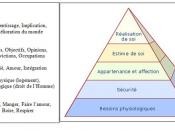Theories of Motivation
Although the term theory is used in motivation theory, no single recognized theory of motivation exists. Rather, motivation is used as an umbrella term for a number of theories that describe factors, traits, or situations that result in people moving beyond awareness and attitudes into behaviors.
A number of workplace theories cite motivation as a key element in employee workplace behavior. Frederick Herzberg's 1959 hygiene theory contends that the external job environment, consisting of hygiene factors such as company policies, supervisor behavior, and salary, must be satisfactory before individuals will be motivated to pursue higher-order, internal motivators such as achievement, recognition, and job advancement.
Another theory of motivation is the 'Hierarchy of Needs' by Abraham Maslow. According to Maslow, individuals have five levels of needs (Maslow 1943): physiological, safety, social, ego, and self- actualizing. Maslow argued that lower level needs had to be satisfied before the next higher level need would motivate individuals.
Maslow's theory has greatly influenced many fields including education and is mainly due to the high level of practicality of the 'Hierarchy of Needs' theory.
In 1954, Maslow first published "Motivation and Personality," which introduced his theory about how people satisfy various personal needs in the context of their work. He postulated, based on his observations as a humanistic psychologist, that there is a general pattern of needs recognition and satisfaction that people follow in generally the same sequence. Maslow also theorized that a person could not recognize or pursue the next higher need in the hierarchy until her or his currently recognized need was substantially or completely satisfied, a concept called prepotency.
Another theory of motivation to be analyzed in this paper is Frederick Herzberg's Theory of Motivators and Hygiene. Herzberg's work categorized motivation into two factors: motivators and hygiene (Herzberg,


